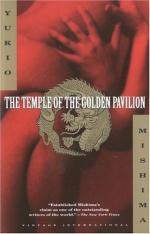|
This section contains 8,494 words (approx. 29 pages at 300 words per page) |

|
SOURCE: Nemoto, Reiko Tachibana. “The Obsession to Destroy Monuments: Mishima and Böll.” Twentieth Century Literature 39, no. 2 (summer 1993): 230-49.
In the following essay, Nemoto analyzes parallels in the post-World War II novels of Mishima and Heinrich Böll, focusing on attitudes toward destruction.
In Japan and in Germany the aftermath of World War II brought a preoccupation with the destruction of monuments (both real and fictional) by fire. In 1950, in the city of Kyoto in Japan, a famous Zen temple that was more than five hundred years old was burned down in an act of arson by a Zen acolyte named Hayashi Yoken, who said that his motive was “antipathy against beauty” (Tasaka 105).1 This event became the subject of Mishima Yukio's 1956 novel Kinkakuji (The Temple of the Golden Pavilion, hereafter Temple), which retells the destruction of the temple from the retrospective viewpoint of an invented arsonist named Mizoguchi...
|
This section contains 8,494 words (approx. 29 pages at 300 words per page) |

|


